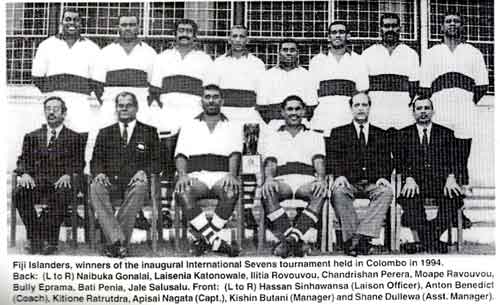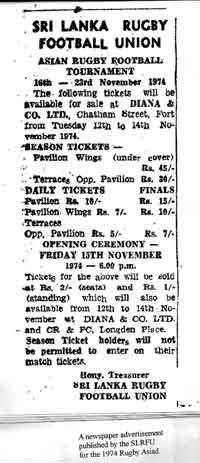Sri Lanka Rugby at home; hosting international matches and tournaments
 Sri Lanka Rugby Football Union (now called Sri Lanka Rugby) is in the process of hosting another international Rugby tournament, the 3rd Leg of the Asia 7′s series, for the 3rd consecutive year.
Sri Lanka Rugby Football Union (now called Sri Lanka Rugby) is in the process of hosting another international Rugby tournament, the 3rd Leg of the Asia 7′s series, for the 3rd consecutive year.
When the first Rugby international was played in Sri Lanka, then Ceylon, in September 1907, between the New Zealand ‘All Blacks’ and the All Ceylon team, interestingly, the match was organised by the CH&FC, being the 1st Rugby club in the island.
The Ceylon Rugby Football Union (CRFU) was not in existence at the time. Upon arrival, the visitors, to whom the hosts had agreed to pay a guarantee fee of US$ 50, were gladly welcomed by the CH&FC officials including its President R. Davidson. The All Blacks were “passing through Colombo by ship, en-route to England, to play the Northern Union.” According to newspaper reports, the visitors “were driven from the Colombo Jetty to the Havelock Race Course by motor car. ——- A crowd of about 4,000 witnessed the game. On entering the field the All Blacks were cheered by the Ceylon team. The visitors returned the compliment and sang their war song.”
The All Blacks vs All Ceylon match was played on Sept.12, 1907, at the CH&FC grounds situated within the Havelock Racecourse. The dominance of the All-European CH&FC in the Rugby arena at the time, was evident, as the All Ceylon team had 8 players from the CH&FC, including the captain A.F. West. The Rresult: All Blacks 33, All Ceylon 6 (2 tries). Referee: J. Lochore.
Commenting on the match result the “Ceylon Sports Annual” said: “The All Blacks were infinitely superior – the acme of combination – different parts performing their functions almost with regularity of a well-oiled machine. Nothing like such an exhibition of Rugby had ever been witnessed in the island.”
Anyhow, the All Blacks’ visit resulted in an unexpected move by the mother union – the English Rugby Football Union, which banned its member countries from playing Rugby in Ceylon. This prohibition was imposed because Ceylon, considered amateurs, had persuaded a professional team to play for a guarantee payment! The formation of the CRFU in 1908 was a direct consequence of this move.
The 1st occasion the CRFU hosted a foreign team was in 1910, when the 2nd Leicester Regiment stationed in Madras, came on a 3-match tour, being the second overseas team to play Rugby on Ceylonese soil. The visitors’ 1st match was on the day of their arrival, against a Combined Colombo XV, which they won handsomely by 27-0. “The Ceylon Independent”, a Colombo-based broadsheet priced at 5 cents per copy, hailed the performance of the visiting team: “Since the ‘All Blacks’, captained by Hercules Wright, played in Colombo in 1907, and gave the local folk an insight into some of the finer points of Rugger, no other touring team has played in the island. So the visit of the Leicester Regimental XV was eagerly looked forward to by all votaries of the game, and those who witnessed the opening match of their tour yesterday afternoon (Aug.16, 1910) were full of admiration for the fine exhibition given by the visiting team.”
This tour also marked the first ever Rugby advertisement by the CRFU, published in August 1910, which read: “Rugby Football – Ceylon vs 2nd Leicester Regiment on Saturday, Aug.20 at Havelock Racecourse. Kick off – 5 pm sharp. Admission: Re.1. –Ladies Free. Chairs will be provided at an extra charge of 50 cents per person.”
The CRFU’s maiden experience in organising and hosting a major Rugby tournament came off through a hurried arrangement. It was the time the All India Rugby Football Tournament held a supreme spot in the island’s Rugby calendar. In 1949, it was Bombay Gymkhana’s turn to host the tourney. But due to unavoidable circumstances they were not in a position to do so, and the CRFU responded quickly and succeeded. The CRFU fielded two teams, All Ceylon and the Ceylon Barbarians, and had the final trial match at Kelani Valley (KV) grounds Talduwa, a few miles away from Colombo, to select the best teams.
 Colombo newspapers called this event a Rugby fiesta. To quote a couple of newspaper previews and reviews: “A week hence, the CRFU will be staging the biggest Rugger tournament ever to be held in Ceylon. Never has there been such general interest centered in a Rugger match in Ceylon since the British RF team played in Colombo on their way home from New Zealand, a long while ago, as in today’s final on the Racecourse.”
Colombo newspapers called this event a Rugby fiesta. To quote a couple of newspaper previews and reviews: “A week hence, the CRFU will be staging the biggest Rugger tournament ever to be held in Ceylon. Never has there been such general interest centered in a Rugger match in Ceylon since the British RF team played in Colombo on their way home from New Zealand, a long while ago, as in today’s final on the Racecourse.”
In the final, All Ceylon led by Lyn Simpson narrowly defeated Calcutta FC 5-3, to regain the coveted All India trophy. The following day, a couple of historic Rugby photographs appeared on the front page of a leading daily broadsheet, a group photograph of the victorious All Ceylon team and also another photograph of Prime Minister D.S. Senanayake watching the match with CRFU President E.F.N. Gratiaen, seated beside him. Perhaps this could be considered the first instance where Rugby was given prominent coverage as a lead story on Page 1 of a prominent national newspaper.
On the eve of the commencement of the tourney, the CRFU hosted a “Men Only” cocktail party at the Royal Colombo Golf Club, in honour of the visiting teams. Honorary membership of several elite local “Clubs” has been granted to the players and officials of the visiting teams during the All India Rugby week. Then, during the grand final between All Ceylon and the Calcutta FC, radio commentary was relayed from the start to finish, from the grounds, ‘for the benefit of those who were unable to witness the game’ .”
In providing accommodation for the visitors from Madras, Calcutta, Bombay and Karachi, the CRFU followed established procedure, an age-old practice in India, causing no monetary burden on the host Union. The host Union found a good number of Rugby enthusiasts, well-wishers, players and administrators who volunteered to host a member or 2 from the visiting teams, at their own cost. Veteran Rugby official Ashram Sookias of Armenian RFC, India, once told me that, during his visit to Colombo with the Bengal Tigers team in 1952, for the All India tourney, they were accommodated at the Orient Club, at the expense of several local Rugby enthusiasts, while some of the team officials were housed in private bungalows.
It took nearly another two-and-a-half decades for the governing body to host an international Rugby tournament. In 1974, Sri Lanka RFU had the privilege of hosting the 4th Asian Rugby Championship (ARC), popularly called Rugby Asiad. Local Rugby reporters called the tourney “the biggest sporting event to be staged in the island until then.” Commander E.L. Matthysz who was then the President of the Asian Rugby Football Union (ARFU), mentioned that “Rugby spectators in Sri Lanka are looking forward to witnessing the participation of other member countries for the 1st time in competitive Rugby on our soil.”
 The commencement of the tournament scheduled for Saturday, Nov.16, 1974, was delayed by the “7-hour curfew imposed in the Colombo District”. Anyhow, the tourney commenced on the following day, and as per sports page reports, “it was a glorious day for Sri Lanka Rugby as Sri Lanka beat Singapore by 10-4, with a tremendous surge of genuine enthusiasm in the final 10 minutes.” Led by Indrajit Coomaraswamy, Sri Lanka thereafter defeated Laos 39-3 and Malaysia 12-6 to become a finalist. The brief write-up that appeared in the print souvenir of the tourney, classified the Skipper of the Sri Lanka team as follows: “Indrajit Coomaraswamy. School: Harrow. Club: Ceylonese Rugby & Football Club. Represented Sri Lanka at the 3rd ARC and against the Bosuns, London Welsh, Emus and Paris XV. Position: Flanker. Occupation: Staff Officer- Central Bank of Ceylon.”
The commencement of the tournament scheduled for Saturday, Nov.16, 1974, was delayed by the “7-hour curfew imposed in the Colombo District”. Anyhow, the tourney commenced on the following day, and as per sports page reports, “it was a glorious day for Sri Lanka Rugby as Sri Lanka beat Singapore by 10-4, with a tremendous surge of genuine enthusiasm in the final 10 minutes.” Led by Indrajit Coomaraswamy, Sri Lanka thereafter defeated Laos 39-3 and Malaysia 12-6 to become a finalist. The brief write-up that appeared in the print souvenir of the tourney, classified the Skipper of the Sri Lanka team as follows: “Indrajit Coomaraswamy. School: Harrow. Club: Ceylonese Rugby & Football Club. Represented Sri Lanka at the 3rd ARC and against the Bosuns, London Welsh, Emus and Paris XV. Position: Flanker. Occupation: Staff Officer- Central Bank of Ceylon.”
At the end, Japan clinched the championship title with a 44-6 victory over the host country, amidst heavy rain. Sports historian S.S. Perera remarked, that the “grounds were more a lake than a Rugger field.”
The SLRFU’s maiden attempt in organising a major Rugby tournament was greatly appreciated and duly rewarded. ARFU Sec.Gen. and Japan RFU Chairman Shigeru (Shiggy) Konno, “congratulated the SLRFU for the good administration and arrangements which prevailed throughout the tournament.” During the tournament, he also made an exclusive announcement, offering “a 2-week training course to one of the local coaches, with all expenses, including air travel to be met by Japan RFU.” According to another newspaper report, “he (Shiggy Konno) said Sri Lanka’s Rugby has improved tremendously since they arrived in the island. He attributed this to the tournament atmosphere. He also spoke highly of the match arrangements.”
But, Australian RFU President Bill Mcloughlin, who was in Sri Lanka on the invitation of the SLRFU, for the 4th Asiad, cautioned: “Spectator violence is creeping into your Rugger matches. This is a bad sign. The local Union must enforce stricter crowd control to prevent such situation.” Anyhow, he paid “tribute to the organisers of the competition saying, the tournament was well organised.”
The SLRFU organised and conducted its first ever international 7s competition on Oct.1-2, 1994. It was played not at the ‘Twickenham’ of local Rugby but at ‘Wembley’ of local Football, Sugathadasa Stadium, an alien arena for Rugby until then. Well known Rugby stalwart Y.C. Chang was the Chairman of the Organising Committee, with Jeff Matheson as its Technical Director. Teams from Australia, Bulgaria, USA, Korea, Malaysia, Singapore, Wales, Arabian Gulf, New Zealand, Netherlands and Fiji, along with the host nation, scrummed down in this 2-day competition which comprised foreign club teams as well as respective Rugby unions’ representative squads. The team tagged “The Islanders- Fiji 2″ made up of the best FijianRugby talent available in Sri Lanka at the time, and our own Chandrishan Perera, thrilled and stunned the packed Stadium with their delectable display of open Rugby, making good use of their speed, power and pace to lay hands on the championship trophy.


